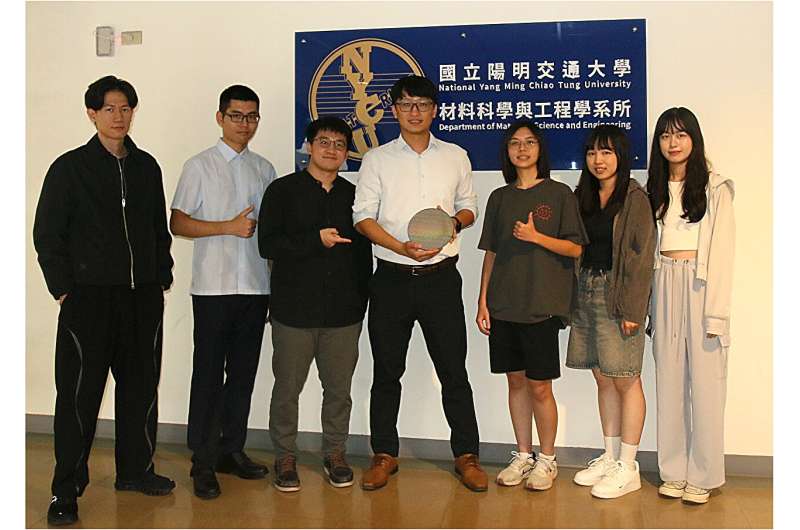The ability to reliably switch the direction of magnetic alignment in materials, a process known as magnetization switching, is known to be central to the functioning of most memory devices. One known strategy to achieve entails the creation of a rotational force (i.e., torque) on electron spins via an electric current; a physical effect known as spin-orbit torque (SOT).
Information storage devices that rely on this effect are called spin-orbit torque magnetic random-access memories (SOT-MRAMs). These memory systems have been found to have various notable advantages, such as the ability to retain data even when their electrical power is turned off, fast switching compared to other various existing memory solutions and low power consumption.
Researchers at National Yang Ming Chiao Tung University, the Taiwan Semiconductor Manufacturing Company, the Industrial Technology Research Institute and other institutes recently developed a new SOT-MRAM based on composite materials that contain the heavy metal tungsten, which is known for its strong spin-orbit coupling. Their memory device, introduced in a paper published in Nature Electronics, could be fabricated via existing processes for the large-scale production of semiconductors.
“Our motivation came from the need for truly low-power, high-speed, and reliable memory to support next-generation computing,” Yen-Lin Huang, first author of the paper, told Tech Xplore. “While spin-orbit torque MRAM had long been proposed, the challenge was to demonstrate nanosecond switching, long retention, and large-scale integration under semiconductor industry-compatible processes.”
The main objective of the recent study by Huang and his colleagues was to develop a MRAM that can simultaneously achieve speed and endurance, but that can also be manufactured using processes that are widely employed within the electronics industry. The memory device they created stores information in a thin ferromagnetic layer’s direction of magnetization.

“Instead of using a magnetic field, we employ spin-orbit torque—a current through a tungsten layer generates spins that flip the magnetization within ~1 ns,” explained Huang.
“Compared to DRAM and Flash, our MRAM combines non-volatility (like Flash) with nanosecond speed (like DRAM), but with much lower power and no need for refresh cycles. The unique aspect here is stabilizing the tungsten phase to deliver both high spin efficiency and industry-ready integration.”
The researchers realized a prototype of their memory, with a 64 kilobit (kb) array, then assessed its performance in conditions aligned with real-world applications. The SOT-MRAM was found to achieve a remarkable switching speed of 1ns and a retention time above 10 years.
“We stabilized a phase of tungsten that is usually difficult to control but crucial for spin efficiency up to 700 °C,” said Huang. “Our study shows that SOT-MRAM can be scaled toward on-chip cache and embedded memory, enabling energy-efficient AI and edge computing where both speed and non-volatility matter.”
The recent work by Huang and his colleagues could open new possibilities for the scalable and large-scale fabrication of highly performing SOT-MRAMs based on β-phase tungsten. In the future, other research teams could build on this study to develop other memory systems that are fast, stable and compatible with existing manufacturing processes.
“We now aim to move beyond proof-of-concept arrays toward megabit-class integration, while further reducing the write current to below sub-picojoule/bit levels,” added Huang. “On the physics side, we are exploring new oxide and 2D interfaces to push efficiency and reliability even further. Another direction is system-level demonstrations—showing how MRAM can cut total power in AI accelerators and mobile devices.”
Written for you by our author Ingrid Fadelli, edited by Gaby Clark, and fact-checked and reviewed by Robert Egan—this article is the result of careful human work. We rely on readers like you to keep independent science journalism alive.
If this reporting matters to you,
please consider a donation (especially monthly).
You’ll get an ad-free account as a thank-you.
More information:
Yen-Lin Huang et al, A 64-kilobit spin–orbit torque magnetic random-access memory based on back-end-of-line-compatible β-tungsten, Nature Electronics (2025). DOI: 10.1038/s41928-025-01434-x.
© 2025 Science X Network
Citation:
Next-generation memory: Tungsten-based SOT-MRAM achieves nanosecond switching and low-power data storage (2025, October 13)
retrieved 13 October 2025
from https://techxplore.com/news/2025-10-generation-memory-tungsten-based-sot.html
This document is subject to copyright. Apart from any fair dealing for the purpose of private study or research, no
part may be reproduced without the written permission. The content is provided for information purposes only.

